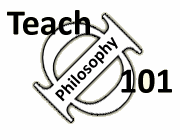Teach Philosophy 101
Free resources for
philosophy teachers!
"One of the most comprehensive, well-researched, and accessible guides for teachers that I have ever seen." James Lang, Chronicle of Higher Education (read full review of TΦ101)
Learning Styles
People who are attracted to philosophy as a career often share some commonalities of thinking and learning styles. Our students do not necessarily share these styles, nor do they all have the same learning style as each other. This suggests that students will learn most if we employ a variety of teaching styles. Switching up the methodology gives students who respond to each approach as an opportunity to learn in a way that is easier for them. At the same time, a new approach challenges those students who are less comfortable in that style and helps them expand their repertoire.
One of the most popular typologies of learning styles is the Myers-Briggs Type Indicator (MBTI), which sorts people out on four dimensions. Below we sumarize MBTI, drawing heavily on Erickson, Peters, Strommer (39-41). The point is not to slavishly focus on Myers-Briggs (which has its reasonable detractors) but to see that different styles require different strategies.
MBTI dimensions and implications for philosophy teachers
Extraversion-Introversion:
Some people tend to be externally focused, and they thrive on discussion and activity. Students like this will raise their hand without even knowing entirely what they want to say, figuring that they will work their thoughts out by talking. Others are more internally focused, and they like to think through and plan their ideas before expressing them.
Implications: Many classrooms favor extraverts, who enjoy raising their hands and contribution. The quieter students will often say, “I like to think through what I am going to say, but by the time I get my ideas together, the discussion has moved on to something else.” Many teachers struggle with the question of how to get more students to participate in class discussion, and often, the solution is to create an environment that allows introverted students to flourish. For example, instead of addressing a question to the whole class (and letting the extraverts dominate), ask students to take a moment to jot down their ideas. Then the teacher can address one of quieter students and say, “What did you write?” This gives the introverts time to collect their thoughts.
Sensing-Intuition:
Sensing students begin in experience and then gradually move toward abstractions. Intuitive students begin in the world of ideas, working deductively toward the concrete implications.
Implications: Philosophy instructors are often comfortable with abstractions, so students who are more intuitive are more likely to understand what we are talking about. Our challenge is to help the sensors, by providing examples that are meaningful to them to illustrate our points; case studies are also effective with sensors.
Thinking-Feeling
Mary Belenky and her colleagues characterize this dimension in by contrasting two different epistemologies. They describe “a separate epistemology [which MBTI calls “thinking”], based upon impersonal procedures for establishing truth, and a connected epistemology ["feeling" in MBTI terms], in which truth emerges through care” (Belenkyet al. 102). Thinking students ground their thought in logical consequences, feeling students think about the human impact of decisions.
Implications:
A lot of the most well known philosophers had a “separate epistemology,” which provides a good challenge to those with a connected epistemology. But we also can reach other students by balancing our courses with material from feminist sources, some of which present a more care-focused world view.
Judging-perceiving
Students on the judging end of this continuum favor organization, planning, and deadlines, while perceiving students are more impulsive and spontaneous.
Implications:
Many professors believe that our job is to help our perceiving students improve their organizational skills, so this might be a place where we want to pick our battles and challenge this learning style rather than support it. However, it is also possible to appeal to the perceiving learning style by giving students more flexibility in assignments and goals.
Conclusion:
If you haven’t read it, take a look at Moulton’s classic article “A Paradigm of Philosophy: The Adversary Method.” In essence, she argues for a more pluralistic model of what philosophy is, at least compared to what some of us learned in our analytically based graduate programs. Exploring different approaches for different learning styles, then, might make good philosophical sense as well as being good pedagogy.
Sources:
Belenky, Mary Field, et al. Women’s Ways of Knowing: The Development of Self, Voice, and Mind. New York: Basic Books, 1986.
Erickson, Brette LaSere, Calvin B. Peters and Diane Weltner Strommer. Teaching First-Year College Students. San Francisco: Jossey-Bass, 2006.
Mollan-Masters, Renee, You Are Smarter Than You Think!: Learning Made Easier in Three Simple Steps. Reality Productions. 2nd ed. 1997. This book is a helpful workbook for students; it attempts to diagnose their learning style, and then suggests strategies for reading and studying.
Moulton, Janice, "A Paradigm of Philosophy: The Adversary Method," Discovering Reality. Ed. Sandra Harding. Dordrecht: Reidel, 1983. 149-164.
Update: 15 Dec. 2015 (E. Tarver)
Author: John Immerwahr
